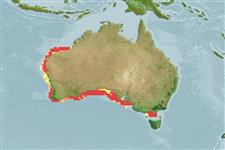分類 / Names
俗名 | 同種異名 | Catalog of Fishes(屬, 種) | ITIS | CoL | WoRMS | Cloffa
Elasmobranchii
板鰓亞綱 (鯊魚與魟魚) (sharks and rays) >
Rhinopristiformes (Shovelnose rays) >
Trygonorrhinidae (Banjo rays, Fiddler rays)
Etymology: Aptychotrema: Greek, a = without + Greek, ptyx, ptychos = fold + Greek, trema = hole (Ref. 45335).
Eponymy: These species and genus are named after the location where the holotypes were caught – the Gulf of St Vincent, near Kangaroo Island, South Australia. (Ref. 128868), visit book page.
Environment: milieu / climate zone / depth range / distribution range
生態學
海洋 居於水底的; 深度上下限 ? - 125 m (Ref. 114953). 亞熱帶的; 19°S - 40°S, 112°E - 147°E (Ref. 114953)
Eastern Indian Ocean: endemic to western and southern Australia.
東印度洋: 澳洲的特有種。
大小 / 重量 / 年齡
Maturity: Lm ? range ? - ? cm
Max length : 84.0 cm TL 雄魚/尚未辨別雌雄; (Ref. 114953)
Occurs near the shore and on the continental shelf from coastal fringe. Common on sandy beaches and seagrass beds (Ref. 006871, Ref. 114953). Mainly feeds on decapod crustaceans and small bony fishes. Females produces litters up to 16 pups. Maturity size for males at ca. 65 cm TL (Ref. 114953). Juveniles are caught with seines.
生活於靠近海岸與在中層大陸棚上。 稚魚被用曳網捕獲。
Life cycle and mating behavior
成熟度 | 繁殖 | 產卵場 | 卵 | 孕卵數 | 仔魚
東印度洋: 澳洲的特有種。
Last, P.R. and J.D. Stevens, 1994. Sharks and rays of Australia. CSIRO, Australia. 513 p. (Ref. 6871)
IUCN 瀕危狀態 (Ref. 130435: Version 2024-2)
無危 (LC) ; Date assessed: 18 February 2015
人類使用
工具
特別的報告
下載 XML
網路資源
Estimates based on models
Preferred temperature (Ref.
123201): 16.3 - 26.7, mean 18.3 °C (based on 218 cells).
Phylogenetic diversity index (Ref.
82804): PD
50 = 0.6250 [Uniqueness, from 0.5 = low to 2.0 = high].
Bayesian length-weight: a=0.00724 (0.00267 - 0.01964), b=3.00 (2.77 - 3.23), in cm total length, based on LWR estimates for this (Sub)family-body shape (Ref.
93245).
營養階層 (Ref.
69278): 3.6 ±0.6 se; based on size and trophs of closest relatives
回復力 (Ref.
120179): 低的, 最小族群倍增時間4.5 - 14 年 (Assuming fecundity<100).
Fishing Vulnerability (Ref.
59153): Moderate to high vulnerability (54 of 100).
